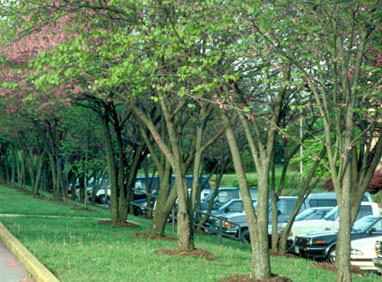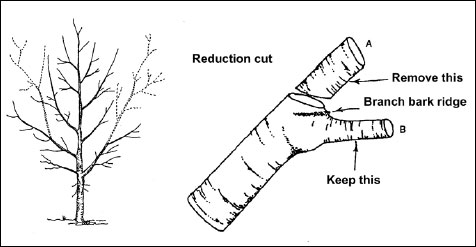Pruning and Maintaining Trees

Hundreds of different kinds of trees can be planted in Florida. Despite the great variety of tree types, there are only a few guiding principles you need to remember when caring for most of them. When you select a tree for your landscape, make sure you know what kind of soil it prefers, how much sun it needs, and any special fertilizer requirements. Otherwise, mulching and pruning will help your tree thrive.
Mulch
Mulch moderates soil temperatures, keeping roots warmer in winter and cooler in the summer. It also helps sustain soil moisture, reducing the water needs of trees. Mulch inhibits weeds, helps reduce soil erosion, and can improve soil, which improves or maintains tree health. To take advantage of all of the benefits of mulch, follow these tips.
- Maintain a 2- to 3-inch layer. Coarse materials, such as pine nuggets, may be applied to a depth of 4 inches, but don’t allow mulch to accumulate to a greater depth. Adding more mulch can harm trees because mulch intercepts rain and irrigation meant for plants’ root systems.
- Avoid “volcano mulching.” When mulch is piled against the base of a tree, it holds moisture, encouraging rot in the trunk. It also encourages roots to grow close to the trunk, which can kill the tree if roots grow around the trunk.
- Mulch to the drip line or beyond. The mulched area around the tree should be at least 8 feet in diameter. Remember that in a forest environment, a tree’s entire root system (which usually extends well beyond the drip line) would be naturally mulched.
- Remove old mulch. Some mulches can become matted, preventing water and air from seeping through. Occasionally (every couple of years), you should remove mulch and soil that is against the trunk, together with any roots growing in the mulch. Remove old mulch before adding fresh mulch to the landscape.
Pruning
Pruning trees selectively removes branches to provide clearance, reduce risk of breakage, or reduce size. When pruning, follow these steps, and then shred the resulting cuttings to add to the compost pile or use as mulch. (You can also toss the cuttings behind a shrub to decompose.)
- Keep it healthy. Remove all dead, diseased, or injured branches.
- Keep it strong. Remove or reduce the length of stems that compete with the main leader.
- Keep it uniform. Remove branches that cross or touch each other and any that look out of place.
- Keep it minor. You should only tackle minor pruning tasks in your landscape. Hire an arborist certified by the International Society of Arboriculture to prune trees taller than about 15 feet. Correct pruning makes trees more resistant to hurricane damage.

Also on Gardening Solutions
Calling the Professionals
If you are unsure about proper tree pruning techniques, consider hiring an arborist—a specialist in the care of trees—to prune your trees. Look for someone who is certified by the International Society of Arboriculture (ISA). Certification indicates that the arborist has been trained through continuing education administered by the ISA.
To find an ISA-certified arborist in your area, check out the International Society of Arboriculture Florida Chapter’s Web site, and search by ZIP code.
Some Tips for Hiring a Quality Arborist
- Ask the arborist for proof of workers’ compensation insurance and check for any permits and licenses required by your local and state government.
- Avoid arborists who advertise they “top” trees.
- Have more than one arborist look at the job and get a written proposal.
- Ask him or her for references and don’t be afraid to check them. Remember, tree care is a long-term investment!
Raking
Many new Floridians avoid having deciduous trees in their yards because they believe that fallen leaves require raking. But deciduous trees reduce energy costs by shading a house in summer and, after leaves fall, by allowing sunshine to heat a house in winter.
Rake up leaves and pine needles and use them as mulch or add them to the compost pile. Or permit leaves to remain under trees to form a self-mulching area. Leaves add nutrients and organic matter to soil as they decompose. If aesthetics are an issue, plant shrubs under trees to avoid raking. The shrubs will benefit from decomposing plant litter and help to hold leaves in place so they won’t clutter the landscape. Keep in mind that some shrubs grow poorly under trees because of competition from tree roots for water and nutrients.
Also on Gardening Solutions
Learn Much More About Trees
- UF/IFAS Landscape Plants — Dr. Edward Gilman
(Don’t be put off by the vague name; this website is the most thorough source of research-based information on trees and shrubs found online.)
